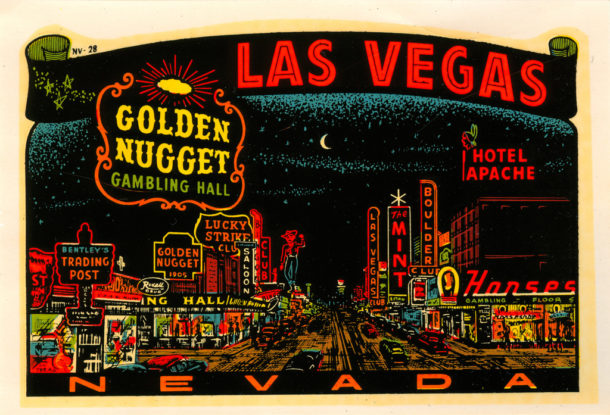According to the Las Vegas timeline, the Entertainment Capital of the World was born in 1905. Although it didn’t get its first gaming license until 1931, it quickly grew into becoming an iconic gambling haven, renowned the world over. Now there are 40 huge casinos in the Vegas Strip area, with a total of 334 gambling houses in the state of Nevada. Visitors to the City of Lights are now topping 42 million each year, making Vegas the sixth most-visited city in America. This is impressive when you think that it is under half the size of New York (which is second in the tourism rankings) at 136 square miles to the Big Apple’s 304. Even though places like Atlantic City and Macau are vying for top spot in the gambling stakes, Vegas continues to go on strong.
Early Years
When Las Vegas was officially founded as a city in 1905, the land was auctioned off in two days. The city quickly became a railway town which serviced passing trains and passengers. The desert location was like a blank canvas, and it soon became apparent that there was bursting potential there. Despite laws banning gambling and alcohol in various different time periods, Vegas had a well-established red light district which provided these vices and carried on regardless. This area was known as Block-16. The construction of the Hoover Dam in 1931 boosted the city’s population and economy at the same time. It brought in thousands of workers to the city who helped Vegas avoid going into financial turmoil during the Great Depression. In that same year the state of Nevada also legalized gambling, opening up plenty of business opportunities for investors in the region. This rapid growth made Vegas the only American metropolitan area founded in the 20th century to reach a population of one million.
During the 1940s the now infamous Las Vegas Strip began. It started with El Rancho Vegas which was designed to be a “man-made oasis” with plenty of leisure activities such as swimming and water sports on the lake. It also had restaurants and a dancing hall, and the idea was to create a complete package that meant that visitors didn’t have to leave the hotel. This became the model for the majority of hotels that occupy the Strip today. In addition to being places to stay, they act as nightlife venues, casinos, restaurants, and places of relaxation.
Blackjack and the Home of Gambling
It didn’t take long for Vegas to establish its reputation as a gambler’s heaven. In the year that the state made gambling legal, the game we know of as blackjack today made its mark in Sin City. At that time, blackjack the popular card game was still known as 21. It was such a hit in Vegas casinos that some proprietors began to offer special odds of 10-1 on hands that combined an ace of spades with one of the black jacks (clubs or aces) to make 21. Apparently the generous rule didn’t stick around for long but the name is still with us to this day. The classic card game has remained hugely popular throughout its history, and in the 1980s it made up around 80% of the total games found in Vegas casinos. It has also gone on to inspire a number of books such as 1997’s Las Vegas Blackjack Diary, and films like 21 which was released in 2008. The rise of signature casinos on the Strip including the Last Frontier, Caesars Palace, Sands, Dunes, and The Sahara all helped to get games like blackjack, roulette, and slots to wider audiences and provide an all-in-one gambling experience which has become the norm nowadays. Superstar entertainers like Frank Sinatra and the Rat Pack simply added to the glitz and glamour of the city, and helped it become the Entertainment Capital of the World.
Water Issues
Even though Las Vegas is one of the most thriving cities on Earth, with top casinos pulling in an average of $630,000 each per day, the city is not without its problems. As one might expect of a city that is surrounded by desert there are some issues concerning the water supply. According to The Telegraph since 2014, after a 14-year drought, the city is engaged in a “potentially catastrophic gamble with nature.” At the time the reservoir that supplies all the water to the city was at risk of running dry. Vegas has managed to stay strong, though, despite problems such as these throughout its history. The state of Nevada has rallied behind these water problems, and has aimed to change legislation on water-rights laws so there will be fewer issues in the future.
The rise and rise of one of the most glamorous cities in the world is a truly remarkable story, and by the looks of things, Vegas will still be one of the most famous gambling locations on the planet for many years to come.
Tags: Hoover Dam
